www.BadgerTrek.comAbout/ContactWeb LogOur Camper Van
Resources:Hobbies:MotorcyclesAmy's CakesOutboard Hydroplane RacingRadio Controlled Toys |
Changing Torqshift 5R110 Transmission Fluid
As the miles built up on our van we came to the point where a transmission fluid change was in order. Unfortunately when I cracked open the manual for our Ford Torqshift transmission, it became apparent that the owner-maintenance was excluded in the design considerations. It has no drain for the torque-converter chamber (over half the fluid), requiring the fluid be expelled by the cooling lines, which are blocked by an internal thermostat. This means the transmission and new fluid must both be hot during the change in order to flush all of the old fluid out without closing the thermostat during the process.
For an official fluid change the truck transmission is to be hooked up to a shop's fluid changing machine which pre-heats the incoming fluid and meters the fluid going in precisely with the fluid exiting. Essentially a sealed container with a diaphragm between two chambers, one of which takes in the old fluid, and displaces the new heated fluid forcing it into the transmission.
A search online led to a number of fragments of instructions on how to accomplish the change without the specialized equipment, but no complete sets of directions, so I pieced it together and decided to post up here with the scheme I used.
A large part of doing the transmission flush is to keep track the amount of fluid drained and the amount sent in. You cannot get too far ahead (3-4qts at the most), nor too far behind (don't want to run the pump dry) on the amount of fluid in the transmission at any given time. To help do this a graduated container to store the waste fluid is needed. Since the van sits so high I chose a 5 gallon Home-Depot bucket and marked each quart inside with a marker (using a 1qt water measure to get the calibration in place). The total fluid flushed out is a touch under 20qts or 5 gallons so I don't need to swap containers as I go.
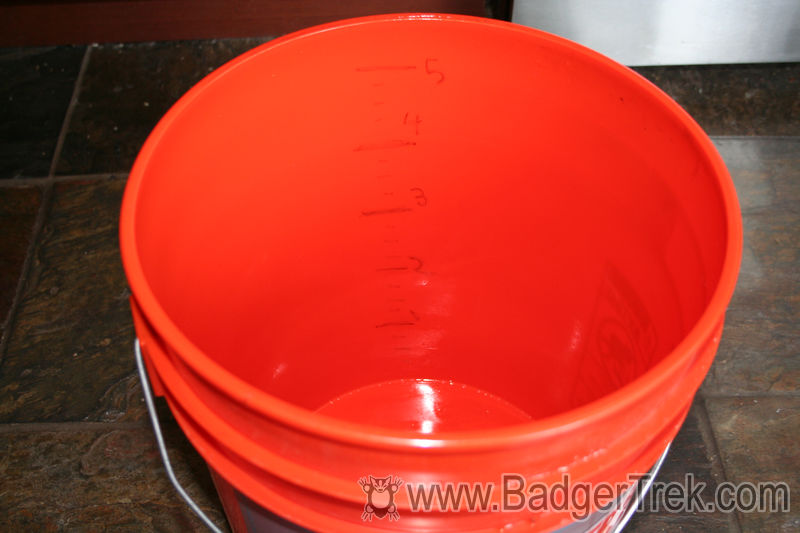
First I needed a method to heat up the transmission before the change. I was doing the change in the middle of winter, and found that after heating up the transmission by driving around on a highway, it would cool too far while I navigated the slow urban roads back home. To keep the heat in I tucked a garbage bag over the grill in front of the transmission cooler, which worked wonderfully.
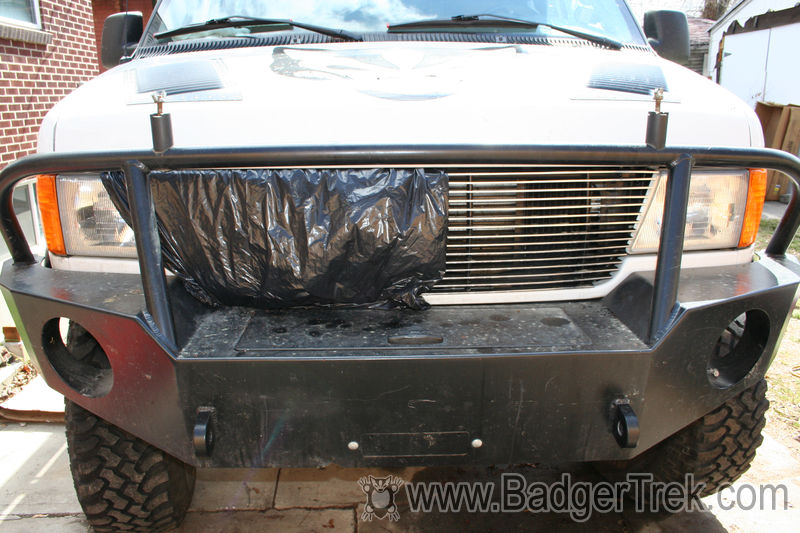
Second I needed a way to heat the new transmission fluid to near 170f. To do this I thought of obtaining one of those nifty new turkey deep-fryers, but ended up opting for the more economical (if potentially dangerous) method of throwing the transmission fluid jugs into the oven on insulated cookie-pans (to keep the radiant heat from the element off the jugs) at the lowest possible setting (200f) for a few hours, periodically checking the temperature with a non-contact thermometer.
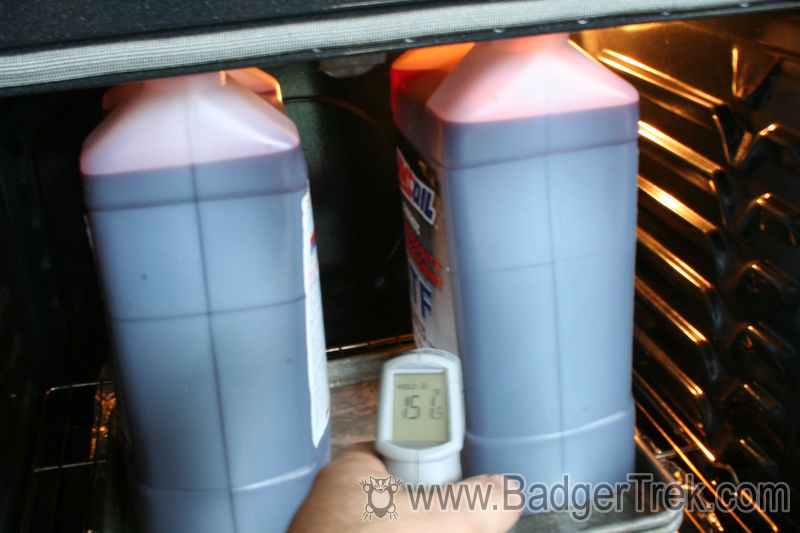
To get the new fluid into the transmission it needs to go down the rather small transmission dipstick tube. To accomplish this with a minimum of danger of burning myself with hot oil I got a super siphon ready. The hose of the siphon jammed perfectly into the dipstick tube, and the jiggle-valve on the other end would quickly start the fluid flowing when needed, no pouring needed.
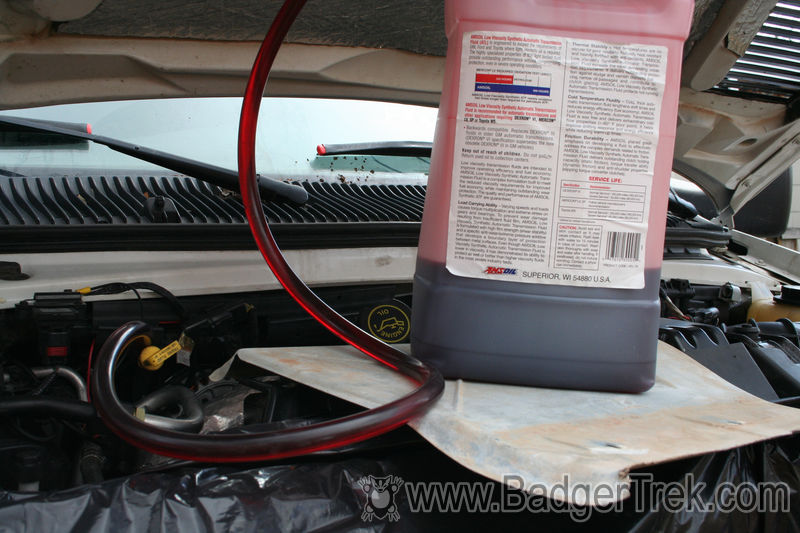
To drain the outgoing fluid I installed a valve on the fluid return line when I put in a transmission filter. Without this valve you can accomplish the same result by loosening the rear most fluid line from the transmission (passenger side, near the transmission support cross-member) and putting a hose over the line leading into the drain bucket. Or, if accessible, pull the line off of the radiator from the transmission.
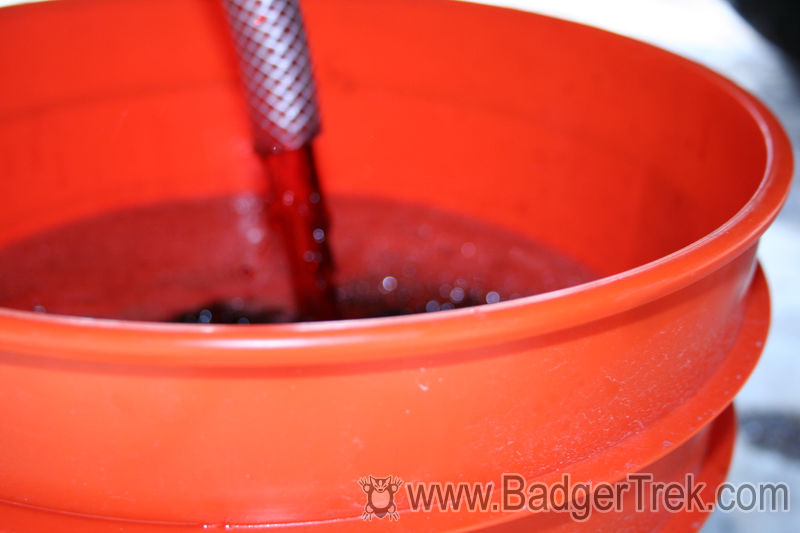
Supplies:
- Leather gloves (you are playing around with hot oil)
- ~20 qts of new transmission fluid, preheated to 170f (Mercon SP rated, NOT Mercon or Mercon V)
- Graduated waste container to measure outgoing fluid (I used a 5gal paint bucket from Home Depot, with lines marked at each quart)
- Hose to lead old fluid from outlet to the waste container
- Siphon with jiggle valve
- ~2'x2' Piece of plywood to hold source fluid containers on engine above dip-stick tube
- An assistant is helpful, especially for steps 7-10
Summarized Steps:
- Pre-heat about 20qts of transmission fluid (I used 2 2.5gal jugs) to about 170deg f.
- Heat up transmission by driving for a few minutes with the transmission cooler airflow blocked (with a gauge aim for about 170deg F, otherwise drive for ~10-20 min).
- Drain from main transmission pan drain (if you have one) (about 7qts)
- Remove transmission fluid filter housing, pull out old filter, pour out fluid, and put in new filter and screw it back in place.
- Place plywood platform on engine to set new fluid containers on. Thread outlet of siphon tube into dip-stick tube.
- Siphon 10 qts of fluid into the transmission dip-stick tube (this overfills the pan by a little bit (3qts) for the moment for the next few steps, but any more and there may be problems)
- Start engine, fluid will immediately begin pumping out of the disconnected line into your graduated bucket.
- Quickly start siphoning the next 10 quarts of fluid into the dipstick tube.
- Run the transmission through all gears, stopping for a few seconds on each so the valves can drain.
- Keep an eye on the amount of fluid pumped out, when the total is about 17-20qts turn off the engine and stop siphoning in new fluid at the same total amount.
- Reattach the disconnected line.
- Clean up and drive about for a bit to flush air out of the filter and cooler. Then stop and check the fluid and adding a bit as necessary (remember to be checking the "hot" level on the dip-stick).
I chose to use 2.5gal transmission fluid containers to source the fluid, as it gave a nice visible indication of how much had siphoned into the transmission, the containers are manageable, and at 10 qts they nicely split the fluid between the two steps (initial re-fill, and re-fill while running).